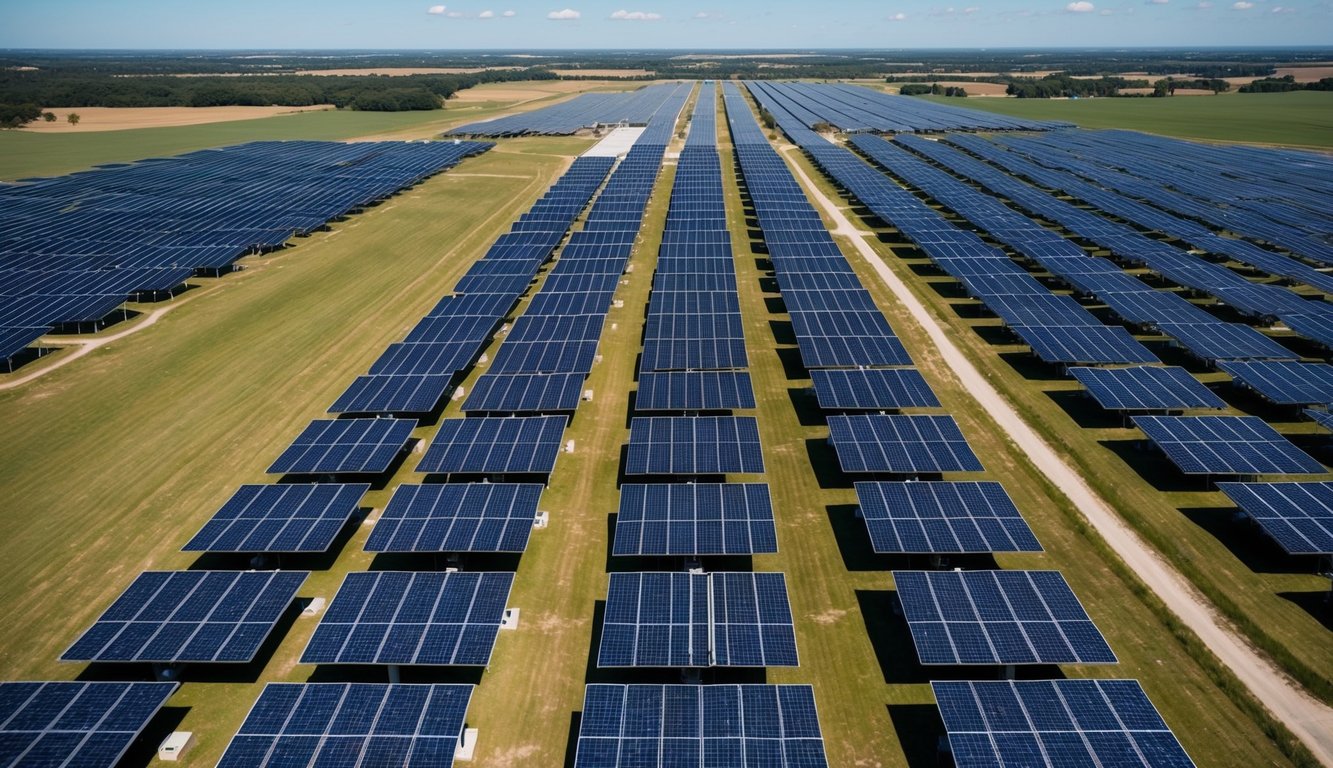Large Scale Solar Parks: Powering Britain’s Sustainable Future
Large-scale solar parks are massive photovoltaic power stations built to supply electricity to the grid. These solar farms cover vast areas, often on agricultural land, and generate clean energy on a commercial scale. Solar parks can produce up to 50 megawatts of power, enough to provide electricity for thousands of homes.
You’ll find solar parks popping up across the UK and worldwide as countries push for more renewable energy. These sites use rows of solar panels to turn sunlight into usable power. Farmers and landowners often lease their fields to developers who build and run the solar farms. This gives rural areas a new source of income while helping meet green energy targets.
As solar technology improves, these parks are becoming more efficient and widespread. New projects aim to create even bigger solar farms that can power hundreds of thousands of homes. With climate change concerns growing, large-scale solar looks set to play a key role in the future of energy production.
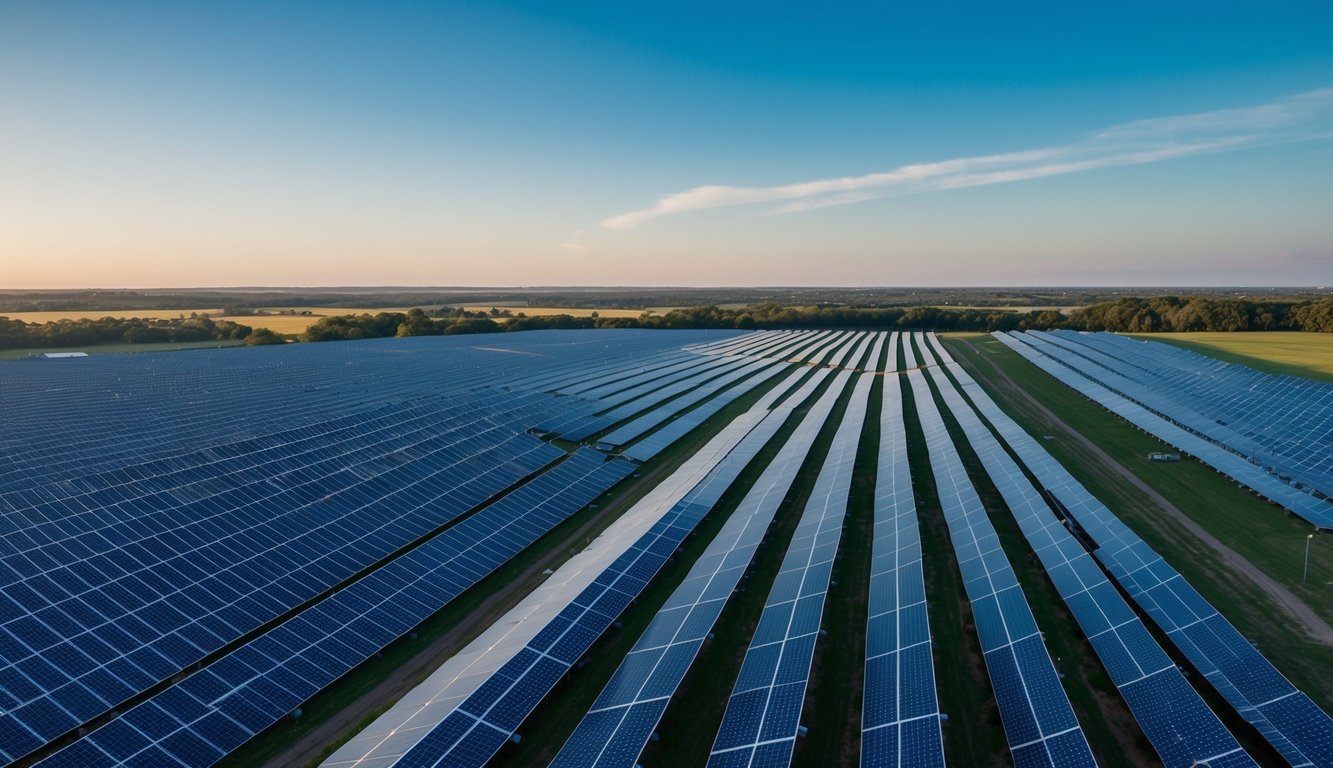
What Are Large Scale Solar Parks?
Large scale solar parks are expansive installations that generate substantial amounts of clean electricity from sunlight. These facilities play a crucial role in the shift towards renewable energy sources.
Definition and Basic Components
Large scale solar parks, also called solar farms or solar power plants, are utility-sized photovoltaic systems designed to supply electricity to the grid. They consist of:
• Solar panels: Arrays of photovoltaic modules that convert sunlight to electricity
• Inverters: Devices that change direct current to alternating current
• Transformers: Equipment that adjusts voltage for grid compatibility
• Mounting structures: Supports that hold panels at optimal angles
These parks are often built on open land, like unused fields or former industrial sites. They can span dozens or hundreds of hectares, depending on their capacity.
Key Features of Utility-Scale Solar
Utility-scale solar parks have several distinctive traits:
• Grid connection: They feed power directly into the electrical grid
• Commercial purpose: The electricity is sold to utilities or large consumers
• Land use: They require significant space, often on leased agricultural land
• Long-term contracts: Parks typically operate under 25-year power purchase agreements
• Environmental benefits: They produce clean energy with minimal emissions
These features allow solar parks to contribute meaningfully to a region’s renewable energy goals.
Typical Size and Capacity Ranges
The size of large scale solar parks can vary widely:
• Area: From about 1 hectare to over 1,000 hectares
• Capacity: Typically range from 1 MW to over 1,000 MW
• Panel count: Can include thousands to millions of solar panels
A 1 MW park might power roughly 200 homes, while the largest can supply electricity to hundreds of thousands. The size often depends on land availability, local energy needs, and grid capacity.

Planning and Development Considerations
Developing large-scale solar parks requires careful planning and consideration of various factors. Key aspects include choosing suitable sites, assessing environmental impacts, securing grid connections, and obtaining necessary permits.
Site Selection Criteria
Selecting the right location is crucial for solar farm success. Suitable sites often have:
• Ample sunlight: Areas with high solar irradiance
• Flat terrain: Minimal shading and easier construction
• Proximity to grid: Reduced connection costs
• Low ecological value: Minimised environmental impact
Developers often prefer brownfield sites or low-grade agricultural land. The UK’s National Planning Policy Framework encourages using previously developed or non-agricultural land when possible.
Solar farms need significant space. A typical 50 MW installation requires about 100 hectares. Developers must balance land availability with project size and output goals.
Local planning policies also influence site choice. Some areas may have restrictions on solar development in certain zones or landscapes.
Environmental Impact Assessment
Solar farm proposals often need an Environmental Impact Assessment (EIA). This process examines potential effects on:
• Wildlife and habitats
• Landscape and visual amenity
• Soil and water resources
• Cultural heritage
EIAs help identify mitigation measures. These might include:
• Creating wildlife corridors
• Planting screening vegetation
• Managing surface water runoff
Developers should engage early with local authorities and environmental groups. This can help address concerns and improve project designs.
Some solar farms incorporate biodiversity enhancements. Examples include wildflower meadows between panels or beehives on-site.
Grid Connection Requirements
Connecting to the electricity grid is a critical step. Developers must:
- Apply to the local Distribution Network Operator (DNO)
- Secure a grid connection offer
- Design and build the connection infrastructure
Costs and timelines vary based on:
• Distance to nearest substation
• Available grid capacity
• Required upgrades to existing infrastructure
Smart grid technologies are becoming more common. These can help manage variable solar output and improve grid stability.
Some projects may need to build new substations or power lines. This can add significant costs and planning complexities.
Land Use and Permitting
Obtaining planning permission is a key hurdle. The process involves:
- Pre-application consultations
- Submitting detailed plans
- Public consultations
- Local authority review
- Potential appeals if refused
Solar farms on agricultural land may need additional approvals. Developers must show the land use change is justified and reversible.
Community engagement is crucial. Addressing local concerns early can smooth the planning process.
Temporary planning permissions are common. These typically last 25-40 years, matching the project lifespan.
Decommissioning plans are often required. These outline how the site will be restored after the solar farm’s operational life.

Technical Components of Solar Parks
Solar parks rely on several key technical components to generate and distribute clean energy efficiently. These elements work together to harness sunlight and convert it into usable electricity for the grid.
Solar Panel Technologies
Solar panels form the heart of any solar park. These photovoltaic devices capture sunlight and turn it into electricity. Modern panels use various technologies:
- Monocrystalline silicon: High efficiency, made from a single crystal structure
- Polycrystalline silicon: Lower cost, slightly less efficient than mono
- Thin-film: Flexible, lightweight panels suited for certain applications
Panel efficiency keeps improving, with some top models now exceeding 22% conversion rates. Bifacial panels can absorb light from both sides, boosting output further.
Mounting Systems and Trackers
Proper mounting ensures panels face the sun optimally. Fixed-tilt systems are simple and low-maintenance. They tilt panels at a set angle based on the site’s latitude.
Solar trackers offer higher yields by following the sun’s path:
- Single-axis trackers: Rotate panels east to west daily
- Dual-axis trackers: Adjust both horizontally and vertically for maximum exposure
Trackers can increase energy production by 25-35% compared to fixed systems. However, they require more upkeep and space between rows.
Inverter and Transformer Stations
Inverters play a crucial role in solar parks. They convert the direct current (DC) from panels into alternating current (AC) for the grid. Large parks often use central inverters that handle power from many panels.
String inverters offer an alternative, connecting to smaller groups of panels. This setup can be more flexible and easier to maintain.
Transformers then step up the voltage for long-distance transmission. These components ensure the park’s output matches grid requirements.
Energy Storage Integration
Many solar parks now include energy storage systems. These help smooth out power delivery and extend usefulness beyond daylight hours. Common storage options include:
- Lithium-ion batteries: Fast response, high efficiency
- Flow batteries: Long duration storage, easily scalable
- Pumped hydro: Where geography allows, can store massive amounts of energy
Storage lets parks provide more reliable power and even offer grid services like frequency regulation. It’s becoming a key part of large-scale solar projects worldwide.

Economic Aspects of Large Solar Parks
Large solar parks involve significant financial considerations. These projects require substantial upfront investment but can generate long-term returns through electricity sales and other revenue streams.
Initial Investment Requirements
Setting up a large solar park demands considerable capital. The main costs include:
Land acquisition: Purchasing or leasing vast tracts of land for the solar arrays.
Equipment: Solar panels, inverters, and mounting systems form the bulk of expenses.
Infrastructure: Building access roads, fencing, and grid connection facilities.
Labour: Hiring skilled workers for installation and setup.
A typical 50 MW solar park might require £40-50 million in initial investment. Costs can vary based on location, technology used, and project scale.
Operational Costs
Running a solar park involves ongoing expenses:
Maintenance: Regular cleaning, repairs, and component replacements.
Security: Protecting valuable equipment from theft or vandalism.
Insurance: Covering potential damages and liabilities.
Staff: Employing technicians and managers for daily operations.
These costs are relatively low compared to fossil fuel plants. A solar park’s operational expenses typically range from 1-2% of the initial investment annually.
Revenue Generation Models
Solar parks earn money through various channels:
Power Purchase Agreements (PPAs): Long-term contracts to sell electricity to utilities or large consumers.
Wholesale market sales: Selling power directly to the grid at market prices.
Renewable Energy Certificates (RECs): Selling green energy credits to organisations seeking to offset their carbon footprint.
Some parks also offer additional services like grid balancing or energy storage, creating extra revenue streams.
Return on Investment Analysis
The profitability of large solar parks depends on several factors:
Electricity prices: Higher rates lead to quicker returns.
Sunlight availability: More sunshine means more power generation.
Government incentives: Subsidies or tax breaks can boost returns.
Financing costs: Lower interest rates improve project economics.
Most solar parks aim for a payback period of 5-10 years. After this, they can generate significant profits for 15-20 years or more. The internal rate of return (IRR) for well-planned projects often ranges from 6-12%.
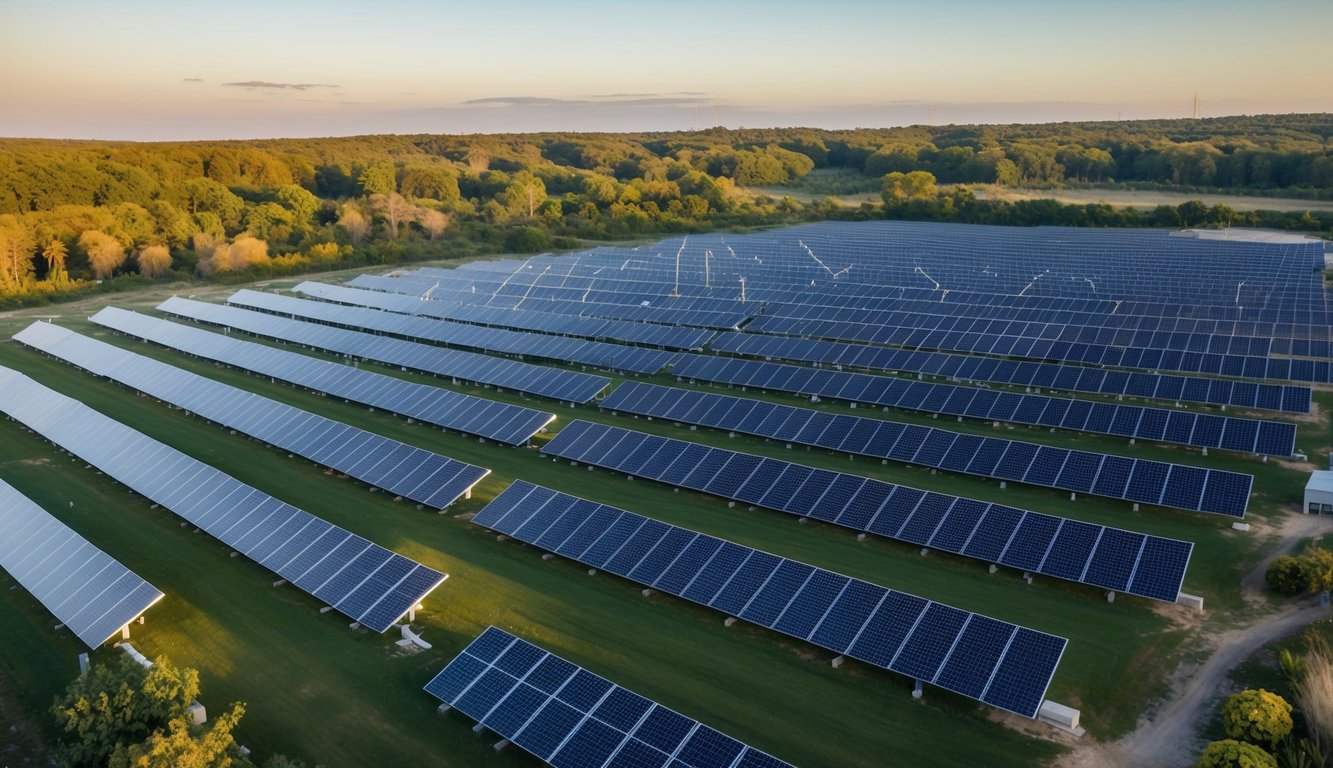
Environmental and Social Impact
Large scale solar parks have significant effects on the environment and local communities. They reduce carbon emissions but also impact ecosystems and land use. These projects can bring benefits like jobs and clean energy to areas.
Carbon Emission Reduction
Solar parks help fight climate change by cutting greenhouse gas emissions. A typical large solar farm can offset thousands of tonnes of CO2 each year compared to fossil fuels. This aids progress towards the UK’s net zero targets.
Solar energy produces no emissions during operation. The carbon footprint mainly comes from manufacturing and installation. But this is paid back within 1-4 years of running. After that, solar parks provide decades of clean power.
Some key points on carbon savings:
- Large farm: Can power 10,000+ homes
- CO2 offset: 20,000+ tonnes per year
- Payback time: 1-4 years for carbon footprint
Local Ecosystem Effects
Solar parks change the land they occupy. This affects plants and animals in the area. Proper planning can limit harm and even boost biodiversity.
Fencing keeps out large animals but allows small ones to pass. This creates a safe haven for some species. Planting native flowers between panels helps bees and other insects thrive.
Some parks use sheep to graze the land. This maintains grassland habitats. Water runoff from panels can create new damp areas good for amphibians.
But solar farms do take up space. Careful site choice avoids prime farmland or sensitive habitats. UK rules aim for “Biodiversity Net Gain” from new projects.
Community Benefits
Solar parks can bring perks to nearby towns and villages. Many developers offer funding for local projects. This might support things like:
- Village hall upgrades
- Play area improvements
- Energy efficiency schemes
Some parks allow community ownership. This lets locals invest and earn from clean energy. Parks often have education programmes too. School visits teach children about renewable power.
There can be downsides. Some people dislike how parks look in rural areas. But most folks get used to them over time. Good landscaping helps them blend in better.
Job Creation Opportunities
Building and running solar parks creates jobs. A large project needs many workers during construction. This brings a boost to local businesses.
Once built, parks need ongoing care. This provides steady work for:
- Technicians
- Security staff
- Landscapers
The renewable energy sector is growing fast. People working on solar projects gain skills for future roles. Training programmes help locals access these jobs.
Solar manufacturing also brings employment. As the UK aims to boost domestic production, more factory jobs should appear. These roles support the wider green economy.
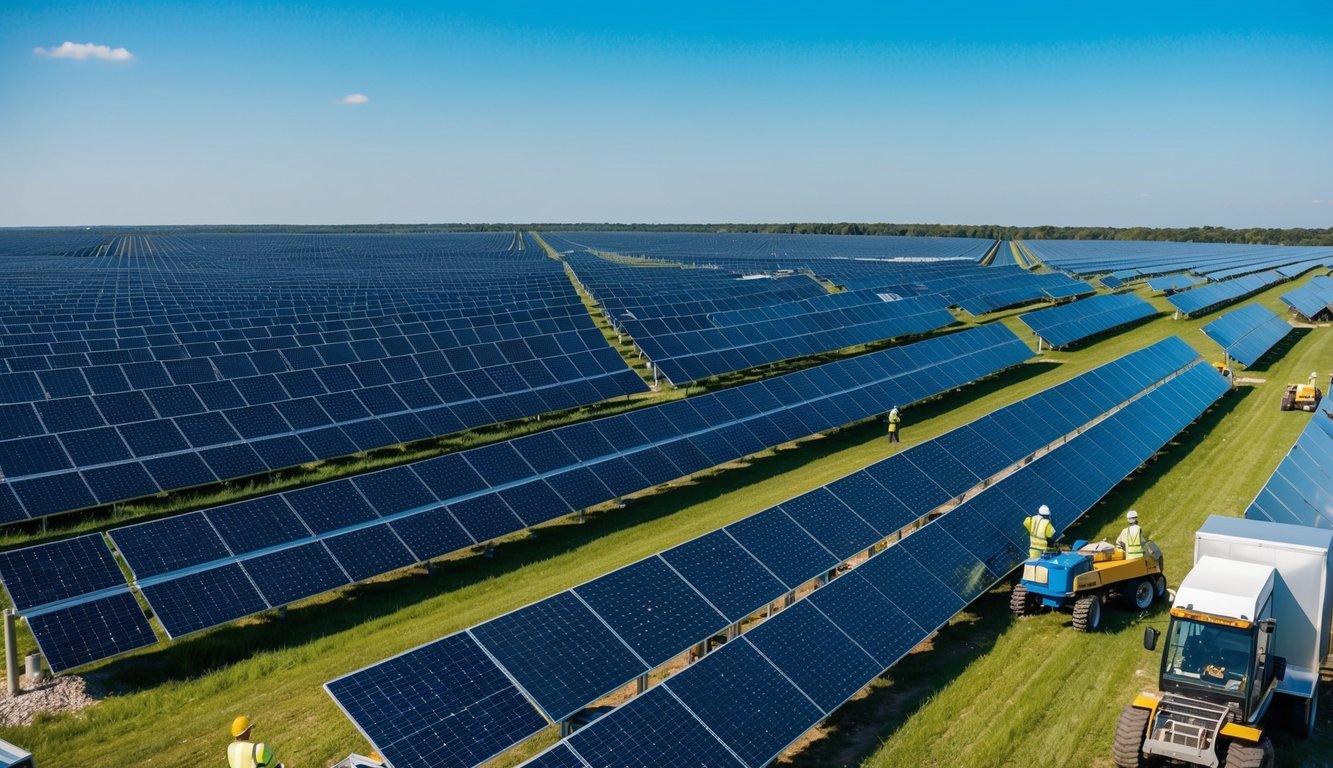
Maintenance and Operations
Proper upkeep and management are vital for large-scale solar parks. These tasks ensure optimal performance, longevity, and safety of the systems.
Regular Maintenance Requirements
Solar parks need routine care to work well. Cleaning panels is a key job. Dust and dirt can lower energy output. Teams should wash panels every few months. They must check for cracks or damage too.
Wiring needs regular checks. Loose or worn cables can cause fires. Fixing these issues quickly is a must. Inverters also need frequent tests. These parts change DC power to AC. When they fail, the whole system suffers.
Ground care is another big task. Teams must trim plants that might block sunlight. They also fix any soil erosion near panels or structures.
• Cleaning: Wash panels every 3-4 months
• Inspections: Check for damage monthly
• Wiring: Test connections quarterly
• Inverters: Service twice a year
• Grounds: Trim plants as needed, fix erosion
Performance Monitoring Systems
Tracking how well a solar park works is crucial. Most sites use special software for this. These systems watch power output all day. They can spot problems fast.
Sensors on panels and inverters send data to a main computer. This info shows how much power each part makes. If one area lags, staff can check it right away.
Some systems can predict issues before they happen. They look at patterns in the data. This helps teams fix things before they break. It cuts down on surprise outages.
Weather stations are often part of these setups. They track sun, wind, and rain. This helps explain changes in power output.
Staff Training and Safety
Workers at solar parks need special skills. They must know about electricity and solar tech. Safety is the top priority. Staff learn how to work with high voltage safely.
Training covers many areas:
- How solar panels and inverters work
- Using tools and test gear
- Reading system data
- Emergency plans
Safety gear is a must. Hard hats, gloves, and special boots protect workers. They also use harnesses when working up high.
First aid training is important too. If someone gets hurt, others can help fast. Regular drills keep these skills sharp.
Lifecycle Management
Solar parks last a long time, but parts do wear out. Good planning helps manage this. Most panels work well for 25-30 years. Inverters often need replacing sooner, about every 10 years.
Keeping spare parts on hand is smart. It means quick fixes when things break. This cuts down on lost power production.
As tech improves, some sites upgrade old gear. New panels can make more power in the same space. Better inverters can be more efficient too.
At the end of life, recycling is key. Many panel parts can be reused. This helps cut waste and saves resources.
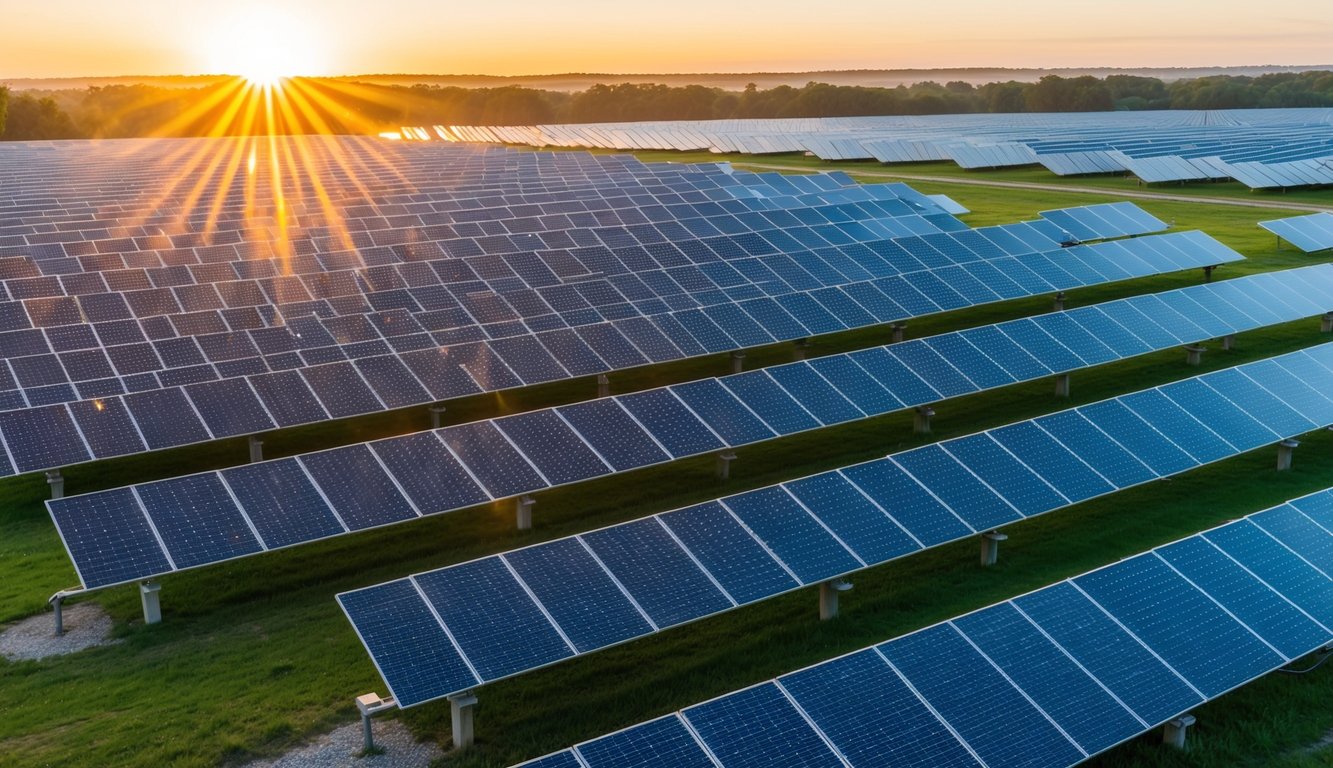
Future of Large Scale Solar Parks
Large scale solar parks are set to play a crucial role in the UK’s renewable energy landscape. New technologies, market shifts, and government policies are shaping their development and integration into the power grid.
Emerging Technologies
Solar panel efficiency is improving rapidly. New designs capture more sunlight and convert it to electricity better than ever. Bifacial panels that collect light on both sides are becoming common. They boost output by up to 30% compared to standard panels.
Energy storage systems are also advancing. Batteries can now store more power for longer periods. This helps solar parks provide steady electricity even when the sun isn’t shining.
Robotic cleaning systems are being used more often. They keep panels free from dirt and dust without using water. This boosts efficiency and cuts maintenance costs.
Floating solar farms are a new trend. They’re built on reservoirs and lakes. This saves land and reduces water evaporation.
Market Trends
The cost of building large solar parks continues to fall. This makes them more appealing to investors. Many new projects are being planned across the UK.
Corporate buyers are driving demand. Big companies want to use clean energy to meet their climate goals. They’re signing long-term deals to buy power from solar parks.
Community-owned solar projects are growing. Local groups are pooling money to build their own parks. This gives them control over their energy supply.
The job market in solar is booming. More workers are needed to design, build, and run these parks. This is creating new jobs in many parts of the country.
Policy Developments
The UK government backs large-scale solar projects. It sees them as key to meeting climate targets. New policies aim to speed up planning and grid connections.
Subsidy-free solar parks are becoming more common. They can now compete with fossil fuels without government support. This is changing how projects are funded.
Local councils are updating their rules. Many are making it easier to build solar parks on their land. Some are even investing in projects themselves.
New guidelines are being made for building on farmland. They aim to balance food production with clean energy needs.
Integration with Smart Grids
Solar parks are being linked to smart grids. These advanced networks can manage power flows better. They help balance supply and demand in real-time.
Virtual power plants are being created. These link many solar sites together. They act as one big power station, making the grid more stable.
Smart inverters are being fitted to solar parks. They can adjust power output quickly. This helps keep the grid stable when clouds pass over.
Demand response systems are being used more. They encourage users to change when they use power. This helps match usage to solar output.
AI is being used to predict solar output. This helps grid operators plan better. It makes solar power more reliable and easier to use.
Conclusion
Large-scale solar parks play a crucial role in the shift towards clean energy. These vast installations harness sunlight to generate electricity, powering homes and businesses alike. Solar parks offer scalability, allowing them to meet growing energy demands.
You’ll find these projects bring many benefits to local communities. They create jobs and boost economies. Solar farms also help reduce carbon emissions, contributing to a greener future.
Some key points about large-scale solar parks:
• Efficiency: Modern panels convert up to 20% of sunlight into electricity
• Land use: Parks can cover several acres, but often on unused or low-quality land
• Power output: Capable of generating enough electricity for entire cities
• Technology: Constantly improving, with new innovations increasing output
As solar technology advances, these parks become more effective. Researchers are working on ways to boost panel efficiency even further. This means more power from the same amount of space.
Solar parks face challenges too. They need careful planning to minimise impact on wildlife and landscapes. But with thoughtful design, these issues can be managed.
The future looks bright for large-scale solar. As costs drop and efficiency rises, expect to see more of these clean energy powerhouses dotting the countryside.
Frequently Asked Questions
Large-scale solar parks have become a key part of the global shift towards renewable energy. These massive installations generate significant amounts of clean electricity, helping to reduce reliance on fossil fuels.
What are the top ten largest solar power plants currently operational globally?
The top ten largest solar power plants span several countries. China’s Xinjiang Solar Farm leads with a 5GW capacity. India’s Bhadla Solar Park and China’s Golmud Solar Park follow closely. Other major plants include Egypt’s Benban Solar Park, Mexico’s Villanueva Plant, and Spain’s Francisco Pizarro farm.
Which country is home to the world’s largest solar power installation?
China hosts the world’s largest solar power installation. The Xinjiang Solar Farm boasts a massive 5GW capacity, making it the biggest solar farm globally. China’s commitment to renewable energy has led to the development of many large-scale solar projects across the country.
What are the financial considerations for initiating a large-scale solar project?
Starting a large-scale solar project requires careful financial planning. You need to consider upfront costs for land, equipment, and installation. Ongoing expenses include maintenance and grid connection fees. Government incentives and falling solar panel prices can help offset these costs.
Can investment in large-scale solar parks yield profitable returns?
Yes, large-scale solar parks can be profitable. The cost of solar technology has dropped by 60% since 2010, making it more affordable. In some cases, solar power is now the cheapest electricity source. Long-term power purchase agreements can provide steady income for solar park owners.
Where is Europe’s most substantial solar farm located?
Europe’s largest solar farm is the Francisco Pizarro plant in Spain. This massive installation showcases Spain’s growing role in European solar energy production. The farm’s size and output highlight the potential for large-scale solar projects in Europe.
What has been the development trajectory of large-scale solar parks since 2021?
Since 2021, large-scale solar parks have seen rapid growth. More countries are building utility-scale solar farms to meet renewable energy targets. The USA aims to increase solar power from 5% to 20% of net power by 2050. Asia continues to lead in solar farm development, with 12 of the 15 biggest installations.

